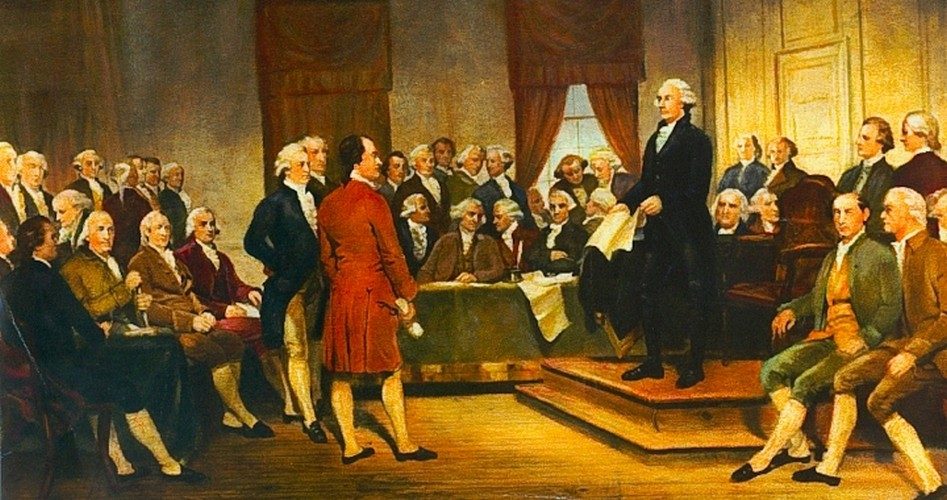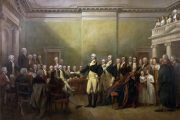
One would be forgiven for believing that once the delegates at the Constitutional Convention of 1787 agreed on a provision, that provision became part of the proposed Constitution. Reading the history of that august meeting, however, reveals that such was rarely the case.
A particularly eventful re-writing of already-agreed-upon articles was accomplished by the so-called Committee of Detail. This committee was established on June 24, 1787, and consisted of John Rutledge of South Carolina, Edmund Randolph of Virginia, Nathaniel Gorham of Massachusetts, Oliver Ellsworth of Connecticut, and James Wilson of Pennsylvania. The membership represented a good cross-section of delegates from southern, northern, and middle states.
On June 24, the convention assigned the committee to draft a “Constitution comfortable to the resolutions passed by the convention.” The group was also to consider the plans for government submitted earlier by Charles Pinckney and William Patterson.
After collaborating on a “constitution” conforming to the instructions given back in June, on Monday, August 6, the committee presented its final product to the convention. The report was a “printed pamphlet of seven folio pages” with wide margins allowing for annotations by the delegates.
In a curious coincidence that has been nearly completely ignored by historians, Oliver Ellsworth and Edmund Randolph served on a similar committee in 1781. This earlier committee, known as the Committee of the Old Congress, was charged with preparing “an exposition of the confederation, a plan for its complete execution, and supplemental articles.” In other words, a substantially similar task as was given to the Committee of Detail six years later. Given the fact that two of the Committee of Detail’s members also worked on the committee drafting the Articles of Confederation, it is interesting to see how many of Ellsworth’s and Randloph’s recommendations for inclusion in the Articles of Confederation also appear in their report prepared in 1787 regarding the new constitution.
Of the various proposals that appear in both reports, there are a few that bear particular note:
• Creation of a mint;
• Fixing a standard of weights and measures throughout the United States;
• Establishing a census; and
• Providing means of compelling states to heed dictates of Congress.
Additionally, the report of 1781 recommended that states cede the following powers to the central government:
1. To lay embargoes during a time of war without limitation,
2. To prescribe rules for impressing property into the service of the U.S. during [the War for Independence],
3. To appoint the collectors of and direct the mode of accounting for taxes imposed according to the requisitions of Congress, and
4. To recognize the independence of and admit into the Federal Union any part of one or more of the U.S., with the consent of the dismembered state.
This final suggestion, of course, has been in the news recently as sections of Colorado and California have made movements toward seceding from the states of which they are now a part.
When delegates looked over the report on August 6, 1787, they found there was a preamble and 23 articles. They also found several changes, some so significant that many of the delegates were “amazed” at the “radical departure” from the Articles of Confederation.
It is important to note, that those awestruck delegates had good reason for their surprise.
This is the last paragraph from the report of the Continental Congress calling for the convention of the states held in Philadelphia begun in May 1787:
Resolved that in the opinion of Congress it is expedient that on the second Monday in May next a Convention of delegates who shall have been appointed by the several states be held at Philadelphia for the sole and express purpose of revising the Articles of Confederation and reporting to Congress and the several legislatures such alterations and provisions therein as shall when agreed to in Congress and confirmed by the states render the federal constitution adequate to the exigencies of Government & the preservation of the Union.
In 1787, the document known as the Articles of Confederation was the capital “C” Constitution of the United States. Article XIII of that Constitution mandated that regarding the making of changes to it: “Nor shall any alteration at any time hereafter be made in any of them; unless such alteration be agreed to in a Congress of the United States, and be afterwards confirmed by the legislatures of every State.”
When the constitutional convention met in Philadelphia in May 1787, that legally binding and constitutional provision was ignored. From the moment Edmund Randolph stood and proposed what was known as the “Virginia Plan,” the Constitutional Convention of 1787 became a “runaway convention.”
There’s no debating that fact. There was a provision of the Constitution prohibiting any changes to the Articles without unanimity. That provision was not only disregarded, but was replaced, eventually, by Article VII of the Constitution created at the convention.
Article VII of our current Constitution reads: “The Ratification of the Conventions of nine States, shall be sufficient for the Establishment of this Constitution between the States so ratifying the Same.”
That’s quite a bit different. With the approval of that new provision, the unanimity rule and the Constitution were replaced.
Hence the amazement.
One the remarkable alterations made by the Committee of Detail to the provisions already approved by their colleagues was in Article VII of the report. Prior to the report, delegates had agreed to grant Congress power “to legislate in all cases for the general interests of the union, and also in those to which the states are separately incompetent, or in which the harmony of the United States may be interrupted by the exercise of individual legislation.”
The Committee of Detail chose to ignore this broad grant of authority and chose to enumerate 18 very specific powers granted by the Constitution to the federal Congress. Seven (at least) of these powers were ported from the Articles of Confederation. Several of the newly listed powers were taken from the plans presented by Charles Pinckney and William Paterson.
Also noteworthy in this list, were the six specific prohibitions on the power of Congress. First, there was the restriction on the crime of treason; next, the provision forbidding export duties; third, the provision dealing with taxes and restrictions on slave migration; fourth, Congress must base any capitation tax on the census; fifth, two-thirds of each house would have to agree on navigation acts; and last, titles of nobility were expressly forbidden.
Another nearly wholesale rewrite by the Committee of Detail of the provisions passed by the delegates was found in Article XI regarding the judiciary. Earlier in the summer, representatives agreed to grant jurisdiction to the federal courts to “cases arising under laws passed by the general legislature; and to such other questions as involved the national peace and harmony.”
Once again, the committee scrapped that expansive language and replaced it with eight specific areas of jurisdiction.
Finally, the committee drafted a very new constitution by inserting two new articles — XII and XIII — concerning the powers of the states. In these two additional provisions — neither of which was ever voted on prior to the committee’s establishment — states were prohibited from coining money, granting letters of marque and reprisal, issuing bills of credit or making anything but specie a tender in payments of debts, and laying duties on imports.
Imagine the state of economic affairs today if states were forbidden from accepting anything but coins as payment for debts.
As the foregoing demonstrates, the delegates were justified in feeling blindsided by the proposed constitution reported to them by the Committee of Detail. Over the next few days, the convention would address the report section by section, changing or chucking those provisions it found most noxious.
The bottom line is, however, that history has forgotten just how far the Constitutional Convention of 1787 exceeded its congressional mandate and just how close we came to having a constitution radically different from the one we have today.
Joe A. Wolverton, II, J.D. is a correspondent for The New American. Follow him on Twitter @TNAJoeWolverton.



